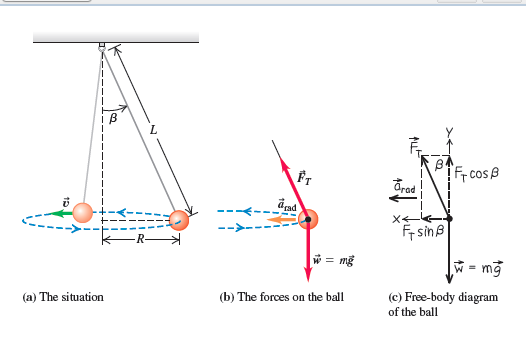
A light rope is attached to it and runs over a pulley. This focuses your attention, preventing you from considering forces that are not acting on the body.Ī block rests on the table, as shown.
CIRCULAR MOTION BODY DIAGRAMS HOW TO
When you are first learning how to draw free-body diagrams, you will find it helpful to circle the object before deciding what forces are acting on that particular object. The object under consideration in each part of this problem was circled in gray. The interface with the inclined plane exerts external forces of N B N B and f B f B, and the interface with object B exerts the normal force N AB N AB and friction f AB f AB N AB N AB is directed away from object B, and f AB f AB is opposing the tendency of the relative motion of object B with respect to object A. Object B experiences two normal forces and two friction forces due to the presence of two contact surfaces. Since object B has a tendency to slide down, object A has a tendency to slide up with respect to the interface, so the friction f BA f BA is directed downward parallel to the inclined plane.Īs noted in step 4 of the problem-solving strategy, we then construct the free-body diagram in Figure 5.32(b) using the same approach. The source of this force is object B, and this normal force is labeled accordingly. Object A has one interface and hence experiences a normal force, directed away from the interface. The weight of the object acts as a force pointing vertically downward, and the presence of the cord indicates a force of tension pointing away from the object. We now include any force that acts on the body. Friction always acts opposite the intended direction of motion. Because object B experiences a component of its weight that pulls it to the left, down the incline, the friction force must oppose it and act up the ramp. Because object A experiences a force that tends to pull it to the right, friction must act to the left. Comparing the two drawings, we see that friction acts in the opposite direction in the two figures. (b) The free-body diagram for isolated object B.

In part (c), we show all forces in terms of their x- and y-components, in keeping with step 3.įigure 5.32 (a) The free-body diagram for isolated object A. In part (b), we show a free-body diagram for this situation, as described by steps 1 and 2 of the problem-solving strategy. In Figure 5.31(a), a sled is pulled by force P at an angle of 30 ° 30 °. Let’s apply the problem-solving strategy in drawing a free-body diagram for a sled. You can label it in a different color to indicate that it is separate from the free-body diagram. Note: If there is acceleration, we do not directly include it in the free-body diagram however, it may help to indicate acceleration outside the free-body diagram.


Consider the types of forces described in Common Forces-normal force, friction, tension, and spring force-as well as weight and applied force. Include all forces that act on the object, representing these forces as vectors.We often place this point at the origin of an xy-coordinate system. If you are treating the object as a particle (no size or shape and no rotation), represent the object as a point. At first, you may want to draw a circle around the object of interest to be sure you focus on labeling the forces acting on the object. Draw the object under consideration it does not have to be artistic.The above forces are the most common, but other forces such as pressure from fluids, spring forces and magnetic forces exist and may act on the body.Observe the following rules when constructing a free-body diagram:

\): The tension force in cables always acts along the direction of the cable and will always be a pulling force.


 0 kommentar(er)
0 kommentar(er)
